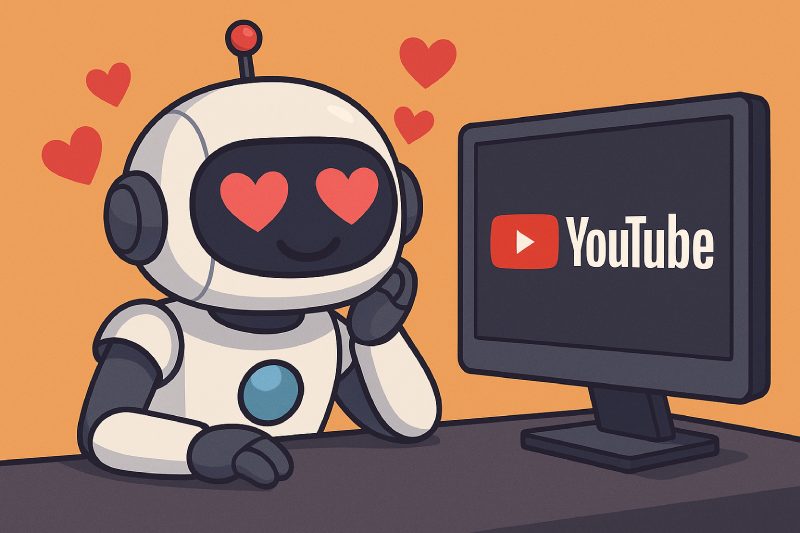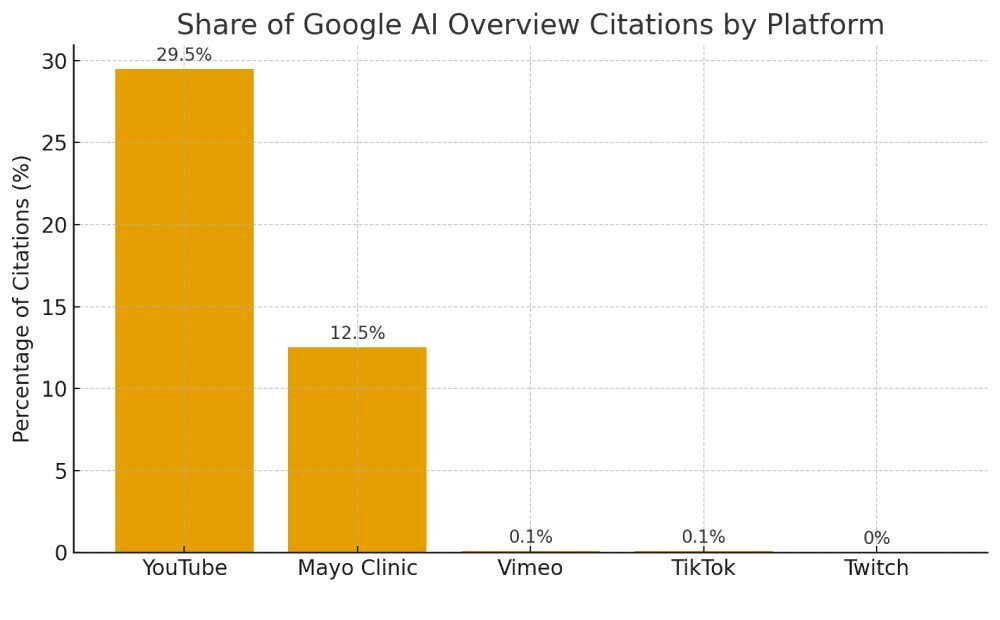Why AI Search Prefers YouTube (And What That Means for Your SEO Strategy)
AI search just made its pick—and it’s not even close.
Fresh data from BrightEdge shows that YouTube now dominates AI-generated search results across ChatGPT, Perplexity, and Google’s own AI Overviews. The scale of the lead? About 200 times greater than its nearest video competitors like Vimeo or TikTok.

TLDR / Key Summary
- YouTube owns 29.5% of all citations in Google’s AI Overviews.
- It holds an average 20% share across all AI platforms.
- Competitors like TikTok and Vimeo barely register at 0.1%.
- AI models now “trust” YouTube for tutorials, product demos, and reviews.
- If your brand isn’t producing video, you’re invisible to AI-driven discovery.
YouTube Isn’t Just a Social Platform Anymore
It’s becoming an AI training dataset.
When tools like ChatGPT and Perplexity generate answers, they often cite external sources. What BrightEdge found is that AI systems overwhelmingly cite YouTube—even when they have no financial incentive to promote Google-owned properties.
Here’s the data breakdown:
- 29.5% of all Google AI Overview citations go to YouTube
- 12.5% go to Mayo Clinic (the next closest domain)
- 0.1% go to Vimeo
- 0.1% go to TikTok
- 0% go to Twitch

This isn’t just brand favoritism. It’s an algorithmic signal that YouTube’s video structure, metadata, and user engagement make it a trusted information source for AI retrieval models.
Where AI Uses YouTube the Most
BrightEdge found YouTube is heavily referenced for topics that show, teach, or demonstrate something.
Top categories where YouTube dominates:
- Software tutorials and walkthroughs
- Medical and finance “how-to” videos
- Product demos and reviews
- Pricing breakdowns and deal comparisons

In other words, anywhere humans want to see something before believing it.
Visual learning content ranks higher because AI models value clarity, engagement, and consistent formatting. YouTube videos—especially those with captions, structured titles, and accurate metadata—fit perfectly into that model.
Where YouTube Shows Up Less
There are areas where AI models don’t rely much on video, at least not yet.
- Career advice
- Business strategy and abstract concepts
- Philosophical or purely informational topics
These are spaces where written content still leads.
So while YouTube owns “how-to” and product-driven searches, blog content remains critical for expertise-driven, thought-leadership queries.
Why AI Trusts YouTube
AI crawlers don’t “like” platforms; they analyze patterns of reliability.
YouTube has three things that make it irresistible to AI models:
- Structured data: Titles, descriptions, captions, and timestamps give clear context.
- Engagement metrics: Views, comments, and watch time reinforce authority signals.
- Topical clustering: Playlists and related videos create semantic relevance, like an internal linking structure for video.

What this means: YouTube has become a machine-readable credibility engine. AI models are effectively treating it like Wikipedia for visual content.
What This Means for SEO in 2025 and 2026
If your brand still treats YouTube as “just social,” you’re missing the future of search.
AI-generated results are pulling video citations more than ever. That means ranking in AI summaries might soon depend on how your brand uses video.
Here’s what to do now:
- Build YouTube into your SEO stack: Treat video titles and descriptions like metadata, not afterthoughts.
- Create tutorials and demos: If your product can be explained visually, it should live on YouTube.
- Use transcripts and captions: They make your content readable by AI and accessible to users.
- Connect blog + video: Embed YouTube videos on your website to strengthen topical authority across formats.
- Measure beyond views: Track CTR from YouTube to your site and see how it influences conversions.
The Big Picture
AI search is evolving faster than traditional SEO can keep up.
Right now, it’s learning who to trust—and it’s picking sources that show rather than tell.
If you want AI systems to quote your brand instead of your competitors, you need to be where AI is looking.
That means YouTube.
Final Thought:
If your SEO strategy doesn’t already include video, you’re not just missing out on audience reach—you’re missing out on AI trust. The brands dominating tomorrow’s search results will be the ones already speaking the language of both humans and machines.
What’s your current video content strategy? (Comment below!)



